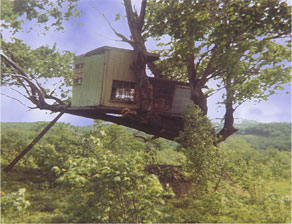Synopsis of “Free Spirits”
“I think Michael always lived under this split personality and he was trying to fight one side off the other. On one hand he was this rock and roll, outlaw biker. And the other part of him was this spiritual master.”
— Dan Brown, member, Brotherhood of the Spirit/Renaissance Community from 1969-1984.

Beginning with high school and Hell’s Angels dropout and spiritual visionary Michael Metelica and eight other hungry teenaged boys in a treehouse in 1968, the Brotherhood of the Spirit/Renaissance Community grew into one of the largest, most successful and controversial communes of its era.
Utopian in outlook, utilizing a mixture of eastern religion, new age mysticism and the yankee work ethic as their philosophical underpinnings; these young people from mostly suburban, middle-class backgrounds sought to establish a new community founded on “New Age” ideals of nonmaterialism, equality, love, and shared labor. “No drugs, no alcohol, no promscuity, and everybody welcome” was its credo. And for several years, for many, it was magical.
But, what started as an experiment in spiritual seeking and simple living by many became, for a time, a wallow in excess for a select few. At its peak in the early to late seventies, the commune boasted four hundred full-time residents, real estate in four Massachusetts towns, its own airplane, Rolls Royce, national rock band, recording studio, and film and video facilities.
During its lifetime, the commune was featured on “The Tonight Show,” “Merv Griffin,” “60 Minutes,” P.B.S.’s “Great American Dream Machine,” “Look Magazine,” “People Magazine,” “Family Circle,” “The Wall Street Journal,” “The New York Times” and other national media, along with hundreds of local newspaper articles. Outsiders either loved or hated the commune - no one was neutral.
Before its final demise in 1988, it directly touched the lives of thousands of people, for better or worse. For some commune members, their time there was the highlight of their lives. For others, it was a nightmare.
Many stayed a decade or more, committing their youth, sweat, and worldly possessions to creating an example of brotherhood and harmony, that, they felt, would serve as a model for the rest of the world. Unfortunately, as it grew, the commune became a microcosm of the world at large, with most of the same problems, structures, and limitations of both American society and Soviet socialism.
The commune’s story, and that of the rise and fall of its inspirational leader and founder, Michael Metelica, reflected a generation. It has elements of a classic Greek Tragedy, as the commune survived the intense hostility of the world around it - governmental attempts to throw them off their land, the burning of communal buildings, cars run off the road, and the brutal murder of a commune member - only to fall because of internal forces, not least of which sprung from the negative changes in Metelica himself.
Yet the commune’s story has many humorous aspects as well - the takeover of the Joey Bishop Show and the Dick Cavett Show by commune members promoting their rock band, “Spirit in Flesh.” The poster barrage of all major U.S. and European cities. The Carnegie Hall Concert. A non-permited march down Fifth Avenue in New York by 1,000 hippies to the headquarters of Metromedia Records to protest the delay in releasing the band’s album, and many other events created by this amazing group of young people whose belief in their cause and each other was only exceeded by their disdain for the norms and regulations of contemporary society.